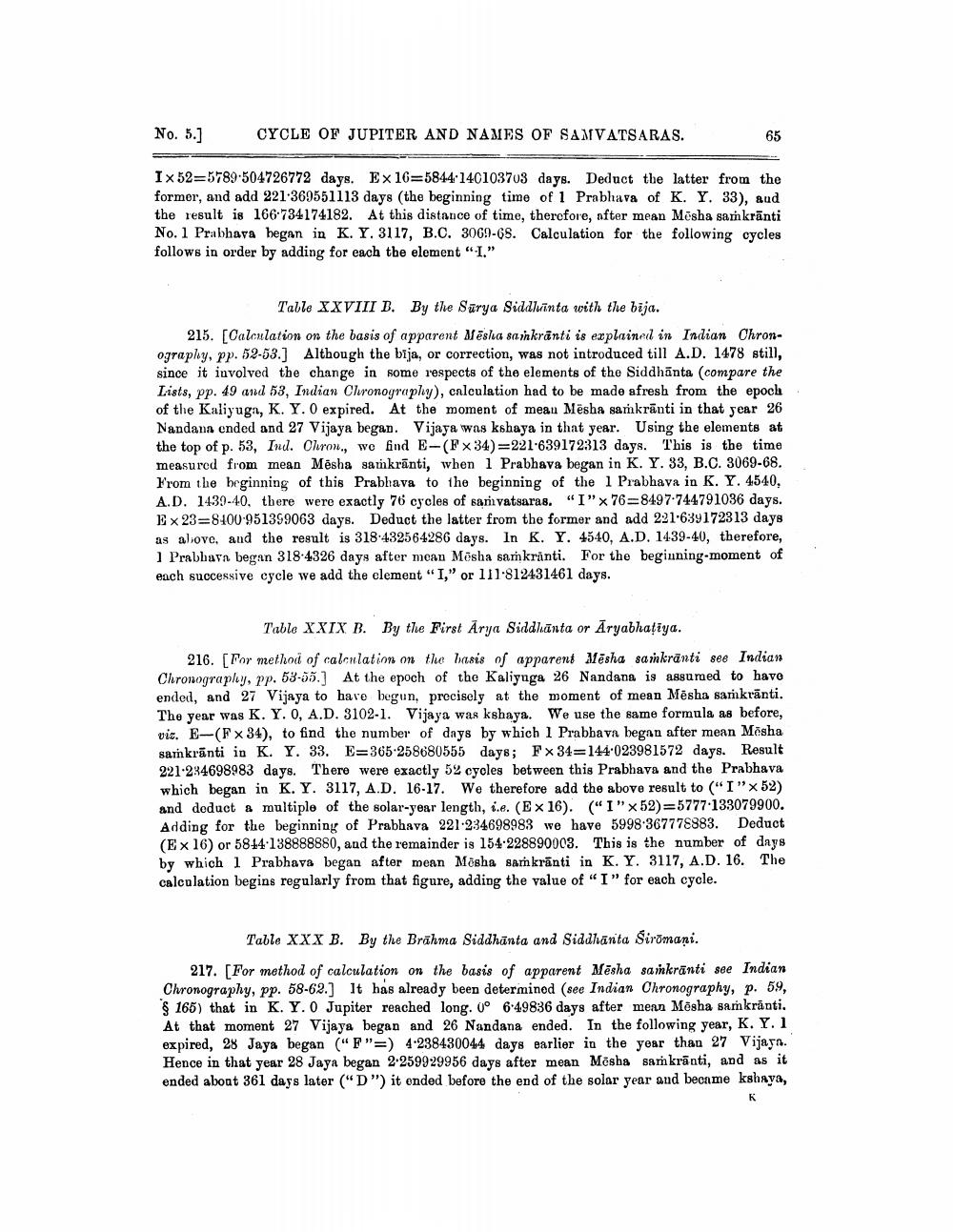________________
No. 5.]
CYCLE OF JUPITER AND NAMES OF SAMVATSARAS.
65
Ix52=5789-504726772 days. Ex16=5844:140103703 days. Deduct the latter from the former, and add 221:369551113 days (the beginning time of 1 Prabhava of K. Y. 33), aud the result is 166-734174182. At this distance of time, therefore, after mean Mesha samkrānti No. 1 Prabhara began in K. Y. 3117, B.C. 3069-68. Calculation for the following cycles follows in order by adding for each the element “1."
Table XXVIII B. By the Sūrya Siddlvinta with the bija. 215. [Calculation on the basis of apparent Mēsla sankranti is explained in Indian Chronography, pp. 52-53.) Although the bija, or correction, was not introduced till A.D. 1478 still, since it involved the change in some respects of the elements of the Siddhānta (compare the Lists, pp. 49 and 53, Indian Cluronograply), calculation had to be made afresh from the epoch of the Kaliyuga, K. Y. O expired. At the moment of meau Mesha sankranti in that year 26 Nandana ended and 27 Vijaya began. Vijaya was kshaya in that year. Using the elements at the top of p. 53, Ind. Chrow., we find E-(FX34)=221-639172313 days. This is the time measured from mean Mesha sankranti, when 1 Prabhava began in K. Y. 33, B.C. 3069-68. From the beginning of this Prabhava to the beginning of the 1 Prabhava in K. Y. 4540, A.D. 1439-40, there were exactly 76 cycles of samvatsaras. "I"x 76=8497-744791036 days. E x 23=8100-951399063 days. Deduct the latter from the former and add 221-639172313 days as above, and the result is 318-432564286 days. In K. Y. 4540, A.D. 1439-40, therefore, 1 Prabhavn began 318-4326 days after mean Mēsha samkrinti. For the beginning-moment of each successive cycle we add the element "T," or 111.812431461 days.
Tabla XXIX B. By the First Arya Siddhanta or Aryabhațiya. 216. [For method of calculation on the basis of apparent Mēsha sankranti see Indian Chronography, pp. 53-55.] At the epoch of the Kaliyuga 26 Nandana is assumed to havo ended, and 27 Vijaya to have begun, precisely at the moment of mean Mēsha samkrānti. The year was K. Y. O, A.D. 3102-1. Vijaya was kshaya. We use the same formula as before, vis. E-(F x 34), to find the number of days by which 1 Prabhava began after mean Mosha samkrānti in K. Y. 33. E=365-258680555 days; Fx 34=144:023981572 days. Result 221-234698983 days. There were exactly 52 cycles between this Prabhava and the Prabhava which began in K. Y. 3117, A.D. 16-17. We therefore add the above result to ("I" x 52) and deduct & multiple of the solar-year length, i.e. (Ex 16). ("I" x 52)=5777-133079900. Adding for the beginning of Prabhava 221-234698983 we have 5998-367778883. Deduct (Ex 16) or 58+4 138888880, and the remainder is 154.228890003. This is the number of days by which 1 Prabhava began after mean Mösha sankranti in K. Y. 3117, A.D. 16. The calculation begins regularly from that figure, adding the value of "I" for each cycle.
Table XXX B. By the Brāhma Siddhānta and Siddhānta Siromani. 217. (For method of calculation on the basis of apparent Mēsha samkrānti see Indian Chronography, pp. 58-62.) It has already been determined (see Indian Chronography, p. 59, $165) that in K. Y. O Jupiter reached long. 0° 6'49836 days after mean Mēsha samkranti. At that moment 27 Vijaya began and 26 Nandana ended. In the following year, K. Y. 1 expired, 28 Jaya began ("F"=) 4.238430044 days earlier in the year than 27 Vijaya. Hence in that year 28 Jaya began 2.259929956 days after mean Mēsba sam krānti, and as it ended about 361 days later ("D") it onded before the end of the solar year and became kshaya,




